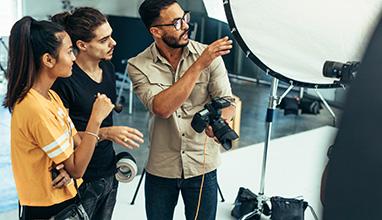The life of a working photographer might seem glamorous to many-taking photos and enjoying the art of this expression-and gaining a salary for it; but the field and function is not all glamour. No career is. This said, you may be wondering if you are considering going into professional photography, what a working day looks like for a photographer. While every job in the photography world is different according to the industry in which you apply your education, experience, and talent; there are some generalities that can be said about the working conditions and life of a professional photographer. We discuss these details below.
One aspect that can affect the working day of a photographer is by who is setting their hours and salary; that is, the difference between the self employed photographer and the photographer employed by a company for their own ongoing needs. For the most part; however, this should not vary that considerably-other than what hours are applied to the contracts or employer: one is fixed and one is as the freelancer dictates.
This said, most often a photographer who wants a regular and somewhat successful salary will always need to be working a steady schedule. Those photographers employed by the government or companies often work a 40 hour week, 5 days a week. Conversely, photographers who work in editorial news entities and periodical often work a 40 hour work week, 5 days a week; and are also on call for breaking news photos that must be taken to depict important news events.
The majority of photographers work on an irregular schedule; however, by snapping their photos according to client schedules, spontaneous events, and the like. This is mostly evocative of freelance photographers, who work part time. For freelance photographers, the options are endless as to how they would like to structure their business and work week; but income is often uncertain and this dictates the working schedule of these individuals.
The actual time spent taking photos for many professional photographers is minimal, when compared to the time spent looking for new clients, editing photos, developing photos (if non-digital), and advertising their talents.
In the world of photojournalists and/or editorial photographers-if they work for an esteemed business-travel is another part of the average working week that should be considered. Not only do these types of photographers often have to travel on a daily or weekly basis as a part of their job, but they must also ensure they can properly take the shot, develop, and edit it-in the remainder of time.
Moreover, in keeping with the traveling circumstances of photojournalists and others in this industry; there are many types of photographers that are required to be in dangerous situations to get the right shots for the purpose. This could be for wildlife photography, during war, in another country of unrest, during natural disasters, and the like; but typically, these life-threatening aspects of the working conditions of a photographer only applies to the high level news photographer or photojournalist.






